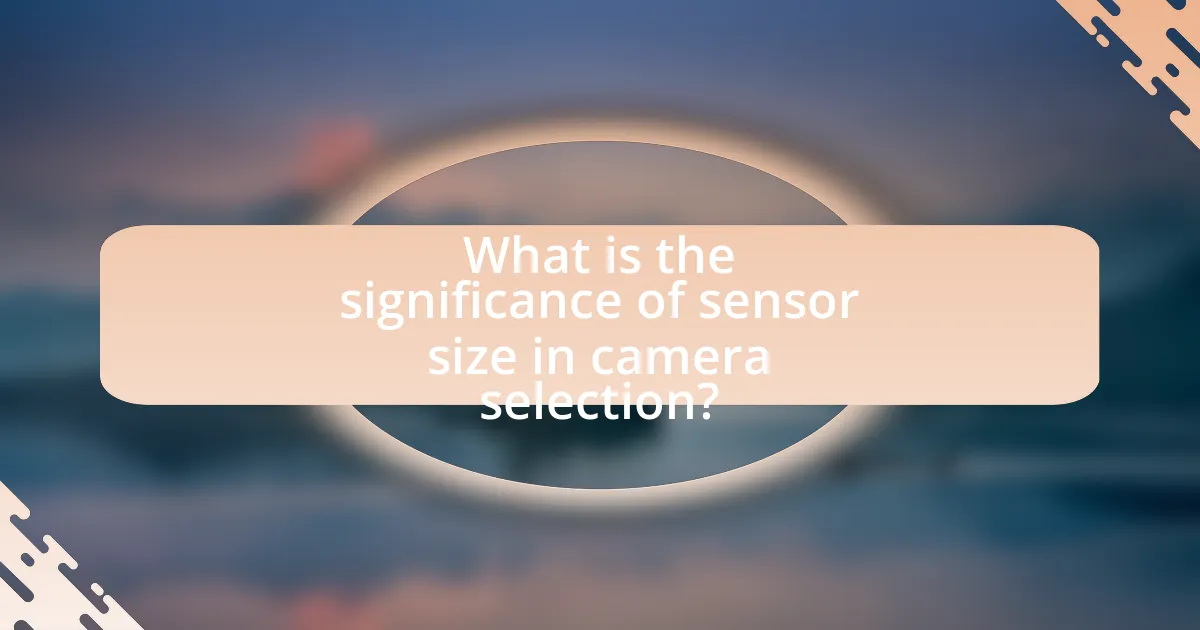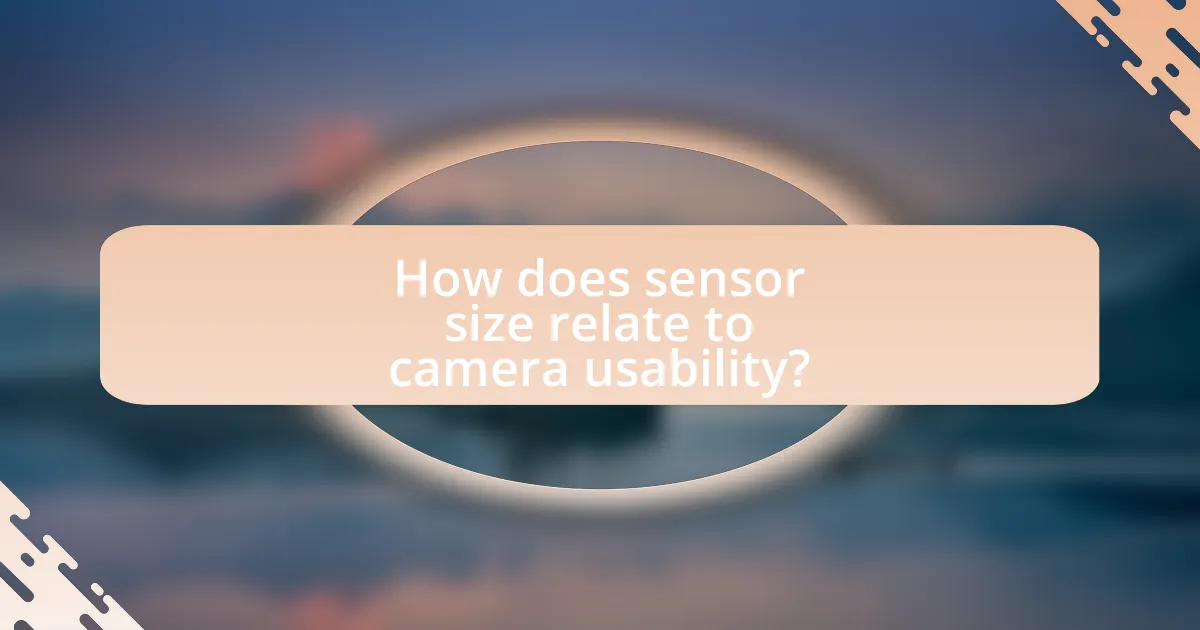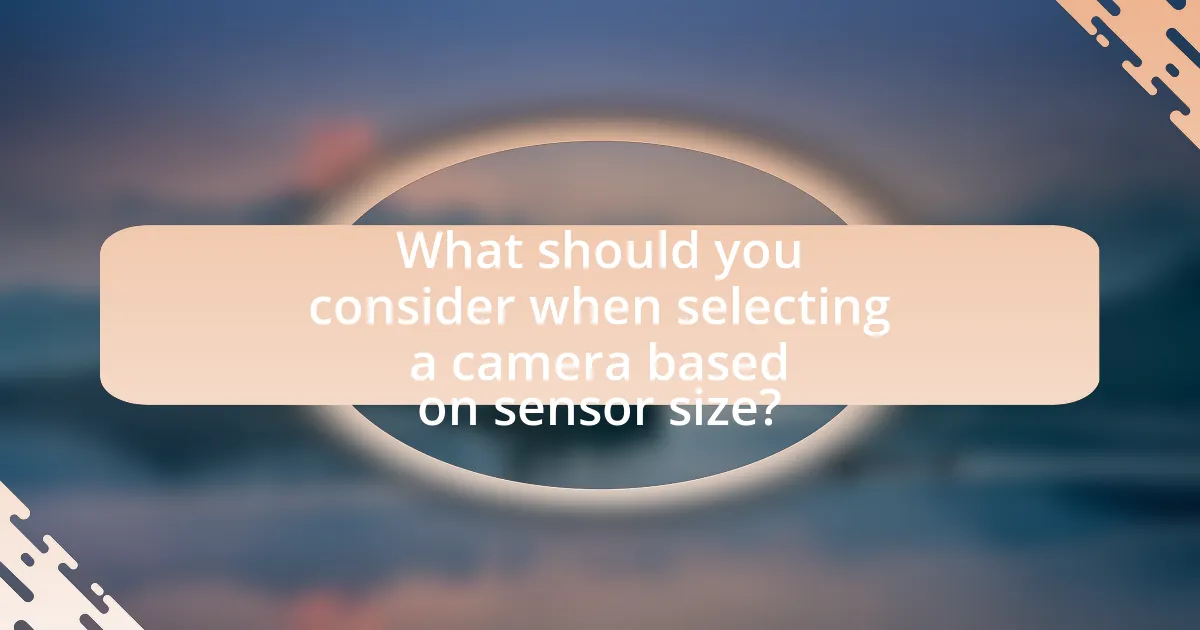The article focuses on the significance of sensor size in camera selection, emphasizing its impact on image quality, depth of field, and low-light performance. It explains how larger sensors, such as full-frame sensors, capture more light, resulting in better dynamic range and reduced noise, which enhances image clarity. The article also discusses the relationship between sensor size and factors like dynamic range, background blur, and lens compatibility, while addressing common misconceptions about sensor size and its implications for photography. Additionally, it provides guidance on selecting the appropriate sensor size based on individual photography needs and budget considerations.

What is the significance of sensor size in camera selection?
Sensor size is significant in camera selection because it directly affects image quality, depth of field, and low-light performance. Larger sensors capture more light, resulting in better dynamic range and reduced noise, which enhances image clarity and detail. For instance, full-frame sensors typically outperform crop sensors in low-light conditions, allowing for higher ISO settings without introducing excessive grain. This relationship between sensor size and image quality is supported by numerous studies, including those from the International Journal of Computer Vision, which highlight the correlation between sensor dimensions and photographic outcomes.
How does sensor size impact image quality?
Sensor size significantly impacts image quality by influencing factors such as light sensitivity, dynamic range, and depth of field. Larger sensors capture more light, resulting in better performance in low-light conditions and reduced noise levels, which enhances overall image clarity. For instance, a full-frame sensor typically offers a higher dynamic range compared to a crop sensor, allowing for more detail in both shadows and highlights. This is supported by studies showing that larger sensors can produce images with less grain and better color accuracy, making them preferable for professional photography.
What role does sensor size play in dynamic range?
Sensor size significantly influences dynamic range, as larger sensors typically capture a wider range of light intensities. This is due to the increased surface area available for light collection, which allows for better differentiation between shadows and highlights. For instance, full-frame sensors can achieve dynamic ranges exceeding 14 stops, while smaller sensors, like those in smartphones, often struggle to exceed 10 stops. This difference is primarily because larger sensors can accommodate larger individual pixels, which enhances their ability to gather light and reduce noise in low-light conditions.
How does sensor size affect low-light performance?
Larger sensor sizes improve low-light performance by capturing more light, which enhances image quality in dim conditions. This is due to the increased surface area of larger sensors, allowing them to gather more photons, resulting in reduced noise and better dynamic range. For instance, full-frame sensors typically outperform crop sensors in low-light scenarios, as evidenced by tests showing that full-frame cameras can maintain usable image quality at higher ISO settings compared to their smaller counterparts.
Why is sensor size important for depth of field?
Sensor size is important for depth of field because larger sensors typically produce a shallower depth of field compared to smaller sensors. This occurs because a larger sensor allows for a wider aperture and a greater distance between the subject and the background, which enhances the ability to isolate subjects with a blurred background. For example, a full-frame sensor can achieve a shallower depth of field than an APS-C sensor at the same aperture setting, making it easier to create a pronounced bokeh effect. This characteristic is crucial for photographers aiming for artistic effects or subject isolation in their images.
How does sensor size influence background blur?
Sensor size significantly influences background blur, also known as bokeh, by affecting the depth of field in an image. Larger sensors, such as full-frame sensors, produce a shallower depth of field compared to smaller sensors, like those found in crop-sensor cameras. This results in more pronounced background blur when using the same aperture settings, allowing subjects to stand out more distinctly against a blurred background.
For instance, a full-frame sensor at f/2.8 will create a more pronounced bokeh effect than a crop sensor at the same aperture due to the larger physical size of the sensor, which captures more light and creates a more significant separation between the subject and the background. This principle is supported by the physics of optics, where larger apertures and sensor sizes contribute to a more significant blur effect in the out-of-focus areas of an image.
What are the implications of sensor size on focal length?
Sensor size directly affects the effective focal length of a lens due to the crop factor associated with different sensor formats. A smaller sensor, such as those found in crop-sensor cameras, results in a longer effective focal length compared to the same lens used on a full-frame sensor. For example, a 50mm lens on a crop sensor with a 1.5x crop factor behaves like a 75mm lens in terms of field of view. This relationship is crucial for photographers as it influences composition, depth of field, and the overall perspective of the image. Understanding this implication allows for better camera and lens selection based on the desired photographic outcome.
What are the different types of camera sensors?
The different types of camera sensors include CCD (Charge-Coupled Device), CMOS (Complementary Metal-Oxide-Semiconductor), Foveon X3, and BSI (Backside Illuminated) sensors. CCD sensors are known for their high image quality and low noise, making them suitable for professional photography. CMOS sensors, on the other hand, are more power-efficient and have faster readout speeds, which is why they are commonly used in smartphones and consumer cameras. Foveon X3 sensors capture color information at each pixel, providing exceptional detail and color accuracy. BSI sensors improve low-light performance by allowing more light to reach the sensor, enhancing image quality in dim conditions. Each type of sensor has unique characteristics that influence camera performance and suitability for various photography needs.
What are the characteristics of full-frame sensors?
Full-frame sensors are characterized by their larger physical size, measuring 36mm x 24mm, which allows for greater light capture and improved image quality. This size contributes to a shallower depth of field, enabling better background blur and subject isolation. Additionally, full-frame sensors typically exhibit lower noise levels at higher ISO settings, enhancing performance in low-light conditions. The larger sensor area also facilitates a wider dynamic range, capturing more detail in both shadows and highlights. These characteristics make full-frame sensors particularly advantageous for professional photography, where image quality is paramount.
How do crop sensors differ from full-frame sensors?
Crop sensors, also known as APS-C sensors, differ from full-frame sensors primarily in their physical size and field of view. Crop sensors typically measure around 22mm x 15mm, while full-frame sensors measure approximately 36mm x 24mm. This size difference results in crop sensors having a crop factor of about 1.5x to 1.6x, which effectively multiplies the focal length of lenses used, leading to a narrower field of view compared to full-frame sensors. Consequently, photographers using crop sensors may find it more challenging to achieve wide-angle shots, while full-frame sensors provide a wider perspective and better low-light performance due to their larger surface area, which can capture more light.

How does sensor size relate to camera usability?
Sensor size directly impacts camera usability by influencing image quality, low-light performance, and depth of field control. Larger sensors typically capture more light, resulting in better image quality and reduced noise in low-light conditions, which enhances usability for photographers in various environments. For instance, full-frame sensors, which are larger than APS-C or Micro Four Thirds sensors, provide superior dynamic range and color accuracy, making them more versatile for professional use. Additionally, larger sensors allow for a shallower depth of field, enabling creative control over focus, which is particularly beneficial for portrait and macro photography. Thus, the relationship between sensor size and camera usability is significant, as it affects the overall performance and flexibility of the camera in different shooting scenarios.
What are the advantages of larger sensors in professional photography?
Larger sensors in professional photography provide enhanced image quality, improved low-light performance, and greater dynamic range. The increased surface area of larger sensors allows for more light capture, resulting in clearer images with less noise, especially in dim conditions. Additionally, larger sensors can produce a wider dynamic range, enabling photographers to capture more detail in both highlights and shadows. For instance, full-frame sensors typically offer better performance than crop sensors, as evidenced by studies showing that full-frame cameras can achieve ISO levels up to 25600 with minimal noise, compared to crop sensors which struggle at similar settings.
How does sensor size affect the weight and size of the camera?
Sensor size directly influences the weight and size of a camera, as larger sensors typically require more substantial housing and components to accommodate their dimensions. Cameras with larger sensors, such as full-frame models, often have bulkier bodies and heavier materials to support the sensor’s size and the necessary optics, while smaller sensors, like those in compact cameras, allow for more lightweight and compact designs. For instance, a full-frame DSLR can weigh over 1,000 grams, while a compact camera with a smaller sensor may weigh less than 300 grams, illustrating the significant impact of sensor size on overall camera dimensions and weight.
What are the trade-offs between sensor size and portability?
Larger sensor sizes typically provide better image quality, low-light performance, and dynamic range, while smaller sensors enhance portability and ease of use. The trade-off arises because larger sensors require more space, making devices bulkier and heavier, which can hinder mobility. For instance, professional cameras with full-frame sensors often weigh significantly more than compact cameras with smaller sensors, impacting their usability for travel or casual photography. This relationship is evident in the market, where mirrorless cameras with smaller sensors are favored for their lightweight design, while DSLRs with larger sensors are preferred for their superior image capabilities.
How does sensor size influence lens compatibility?
Sensor size directly influences lens compatibility by determining the field of view and the effective focal length of lenses used with a camera. Larger sensors typically require lenses designed specifically for their size to avoid vignetting and to achieve optimal image quality. For example, full-frame sensors need full-frame lenses to utilize the entire image circle, while crop sensors can use both crop and full-frame lenses, but with a crop factor that alters the effective focal length. This relationship is crucial for photographers to consider when selecting lenses, as using incompatible lenses can lead to suboptimal performance and image quality issues.
What types of lenses are best suited for different sensor sizes?
Full-frame sensors are best suited for lenses designed for full-frame cameras, such as standard zooms and prime lenses, which provide optimal image quality and depth of field. APS-C sensors benefit from crop factor lenses, typically offering a focal length equivalent to 1.5x, making wide-angle and standard zoom lenses ideal. Micro Four Thirds sensors require lenses that are specifically designed for their crop factor of 2x, favoring compact and lightweight options like pancake lenses and wide-angle primes. Each lens type maximizes the performance and image quality relative to the sensor size, ensuring effective utilization of the camera’s capabilities.
How does sensor size affect the choice of accessories?
Sensor size significantly influences the choice of accessories by determining compatibility and performance characteristics. Larger sensors typically require larger lenses to maintain image quality and achieve desired focal lengths, while smaller sensors can utilize more compact lenses. For instance, a full-frame camera may necessitate high-quality, larger diameter filters and lens hoods to prevent vignetting, whereas a crop sensor camera can often use smaller, lighter accessories. Additionally, the depth of field and low-light performance associated with sensor size affects the selection of tripods and stabilizers, as larger sensors may require more robust support systems to manage the weight and balance of larger lenses.

What should you consider when selecting a camera based on sensor size?
When selecting a camera based on sensor size, consider the impact of sensor dimensions on image quality, depth of field, and low-light performance. Larger sensors, such as full-frame sensors, typically capture more light, resulting in better image quality and reduced noise in low-light conditions. Additionally, larger sensors provide a shallower depth of field, allowing for more pronounced background blur, which is desirable in portrait photography. Conversely, smaller sensors, like those found in compact cameras, may limit these capabilities but can offer advantages in portability and cost. Research indicates that cameras with larger sensors often outperform their smaller counterparts in dynamic range and color accuracy, making sensor size a critical factor in camera selection.
How can you determine the right sensor size for your needs?
To determine the right sensor size for your needs, assess the type of photography you intend to pursue, as different sensor sizes offer varying levels of image quality, depth of field, and low-light performance. For instance, full-frame sensors provide superior image quality and better performance in low light, making them ideal for professional work, while APS-C sensors are more compact and cost-effective, suitable for casual photography. Additionally, consider the lens compatibility and the field of view; larger sensors capture wider angles, which is beneficial for landscape photography. Research indicates that sensor size directly influences the dynamic range and noise levels in images, with larger sensors typically outperforming smaller ones in these aspects.
What factors should you evaluate based on your photography style?
To evaluate factors based on your photography style, consider the type of subjects you capture, the lighting conditions you typically work in, and the desired depth of field. Different photography styles, such as portrait, landscape, or macro, require specific approaches to composition and equipment. For instance, portrait photography often benefits from a wider aperture for shallow depth of field, while landscape photography may require a smaller aperture for greater depth of field. Additionally, understanding how sensor size impacts image quality and low-light performance is crucial, as larger sensors generally provide better dynamic range and noise control, which can significantly influence the final outcome of your images.
How does budget influence your choice of sensor size?
Budget significantly influences the choice of sensor size by limiting the options available for camera purchases. Higher sensor sizes, such as full-frame sensors, typically come with increased costs due to their advanced technology and superior image quality. For instance, a full-frame camera can range from $1,500 to over $3,000, while cameras with smaller sensors, like APS-C or Micro Four Thirds, can be found for $500 to $1,200. Consequently, individuals or organizations with tighter budgets may opt for smaller sensors to stay within financial constraints, impacting the overall image quality and performance. This correlation between budget and sensor size is evident in market trends, where entry-level cameras often feature smaller sensors to accommodate lower price points.
What are some common misconceptions about sensor size?
Common misconceptions about sensor size include the belief that larger sensors always produce better image quality and that sensor size directly correlates with the camera’s overall performance. While larger sensors can capture more light and detail, factors such as lens quality, processing algorithms, and user technique also significantly influence image quality. Additionally, smaller sensors can excel in specific situations, such as in compact cameras or smartphones, where portability and convenience are prioritized. Research indicates that advancements in technology have allowed smaller sensors to produce impressive results, challenging the notion that size is the sole determinant of performance.
Why is bigger not always better in terms of sensor size?
Bigger is not always better in terms of sensor size because larger sensors can lead to increased noise levels in certain conditions and may not always provide better image quality. For instance, while larger sensors typically capture more light, which can enhance low-light performance, they also require larger lenses and can result in more complex camera systems that may not be practical for all users. Additionally, smaller sensors can achieve higher frame rates and faster autofocus in specific scenarios, making them advantageous for certain types of photography, such as sports or wildlife. Thus, the effectiveness of sensor size depends on the specific photographic needs and conditions rather than size alone.
How can understanding sensor size improve your photography skills?
Understanding sensor size can significantly enhance your photography skills by influencing image quality, depth of field, and low-light performance. A larger sensor typically captures more light, resulting in better dynamic range and reduced noise, which is crucial for high-quality images. For instance, full-frame sensors, compared to crop sensors, provide a wider field of view and improved low-light capabilities, allowing photographers to shoot in darker environments without sacrificing clarity. Additionally, understanding how sensor size affects depth of field enables photographers to achieve desired artistic effects, such as background blur, which is more pronounced with larger sensors. This knowledge empowers photographers to make informed decisions about equipment and settings, ultimately leading to improved photographic outcomes.
What tips can help you choose the best camera based on sensor size?
To choose the best camera based on sensor size, prioritize larger sensors for better image quality, especially in low light conditions. Larger sensors, such as full-frame sensors, capture more light and detail, resulting in superior dynamic range and reduced noise compared to smaller sensors like APS-C or Micro Four Thirds. For instance, full-frame sensors typically have a surface area that is approximately 2.5 times larger than APS-C sensors, allowing for better performance in challenging lighting situations. Additionally, consider your photography style; if you often shoot landscapes or portraits, a larger sensor can enhance depth of field control and overall image clarity.